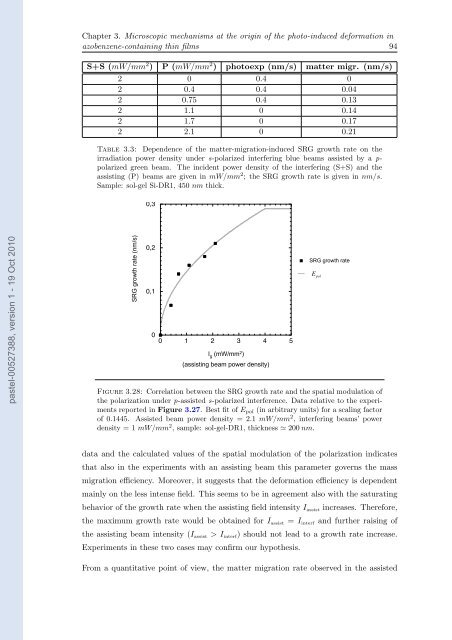- Page 1 and 2:
Thèse de doctorat de l’Ecole Pol
- Page 3 and 4:
AcknowledgementsAt the beginning it
- Page 5 and 6:
vpastel-00527388, version 1 - 19 Oc
- Page 7:
ContentsAbstractiAcknowledgementsii
- Page 10 and 11:
List of Figures1.1 The trans/cis ph
- Page 12 and 13:
List of Figuresxiipastel-00527388,
- Page 14 and 15:
pastel-00527388, version 1 - 19 Oct
- Page 16 and 17:
pastel-00527388, version 1 - 19 Oct
- Page 18 and 19:
Introduction 2In this work, we stud
- Page 20 and 21:
Bibliography[1] A. Natansohn, P. Ro
- Page 22 and 23:
Introduction 6azobenzene-containing
- Page 24 and 25:
"##$%&'()')*#'+(%,-.(/#'011'2'"(%)(
- Page 26 and 27:
Chapter 1. The azobenzene molecules
- Page 28 and 29:
Chapter 1. The azobenzene molecules
- Page 30 and 31:
Chapter 1. The azobenzene molecules
- Page 32 and 33:
Chapter 1. The azobenzene molecules
- Page 34 and 35:
Chapter 1. The azobenzene molecules
- Page 36 and 37:
Chapter 1. The azobenzene molecules
- Page 38 and 39:
Chapter 1. The azobenzene molecules
- Page 40 and 41:
Chapter 2. Experimental setup and s
- Page 42 and 43:
Chapter 2. Experimental setup and s
- Page 44 and 45:
Chapter 2. Experimental setup and s
- Page 46 and 47:
Chapter 2. Experimental setup and s
- Page 49 and 50:
Chapter 2. Experimental setup and s
- Page 51 and 52:
Chapter 2. Experimental setup and s
- Page 54 and 55:
Chapter 2. Experimental setup and s
- Page 56 and 57:
Chapter 2. Experimental setup and s
- Page 58 and 59:
Chapter 2. Experimental setup and s
- Page 60 and 61: Chapter 2. Experimental setup and s
- Page 62 and 63: Chapter 2. Experimental setup and s
- Page 64 and 65: Chapter 2. Experimental setup and s
- Page 66 and 67: pmma-dr1Chapter 2. Experimental set
- Page 68 and 69: Chapter 2. Experimental setup and s
- Page 70 and 71: Chapter 3pastel-00527388, version 1
- Page 72 and 73: Chapter 3. Microscopic mechanisms a
- Page 74 and 75: Chapter 3. Microscopic mechanisms a
- Page 76 and 77: Chapter 3. Microscopic mechanisms a
- Page 78 and 79: dose (mJ!mm )(a)dose (mJ!mm )(b)dos
- Page 80 and 81: Chapter 3. Microscopic mechanisms a
- Page 82 and 83: Chapter 3. Microscopic mechanisms a
- Page 84 and 85: Chapter 3. Microscopic mechanisms a
- Page 86 and 87: Chapter 3. Microscopic mechanisms a
- Page 88 and 89: Chapter 3. Microscopic mechanisms a
- Page 90 and 91: Chapter 3. Microscopic mechanisms a
- Page 92 and 93: Chapter 3. Microscopic mechanisms a
- Page 94 and 95: Chapter 3. Microscopic mechanisms a
- Page 96 and 97: Chapter 3. Microscopic mechanisms a
- Page 98 and 99: TOPOGRAPHYgratamplxxphotoexpansion
- Page 100 and 101: Chapter 3. Microscopic mechanisms a
- Page 102 and 103: Chapter 3. Microscopic mechanisms a
- Page 104 and 105: Chapter 3. Microscopic mechanisms a
- Page 106 and 107: Chapter 3. Microscopic mechanisms a
- Page 108 and 109: Chapter 3. Microscopic mechanisms a
- Page 112 and 113: Chapter 3. Microscopic mechanisms a
- Page 114 and 115: Chapter 3. Microscopic mechanisms a
- Page 116 and 117: Chapter 3. Microscopic mechanisms a
- Page 118 and 119: Chapter 3. Microscopic mechanisms a
- Page 120 and 121: pmmaChapter 3. Microscopic mechanis
- Page 122 and 123: Chapter 3. Microscopic mechanisms a
- Page 124 and 125: Chapter 3. Microscopic mechanisms a
- Page 126 and 127: Chapter 3. Microscopic mechanisms a
- Page 128 and 129: Chapter 3. Microscopic mechanisms a
- Page 130 and 131: Chapter 3. Microscopic mechanisms a
- Page 132 and 133: Chapter 4. Photomechanical response
- Page 134 and 135: sg+goldChapter 4. Photomechanical r
- Page 136 and 137: Chapter 4. Photomechanical response
- Page 138 and 139: Chapter 4. Photomechanical response
- Page 140 and 141: P-250s-4VChapter 4. Photomechanical
- Page 142 and 143: Chapter 4. Photomechanical response
- Page 144 and 145: Chapter 4. Photomechanical response
- Page 146 and 147: P-250s-4VChapter 4. Photomechanical
- Page 148 and 149: Chapter 4. Photomechanical response
- Page 150 and 151: Chapter 4. Photomechanical response
- Page 152 and 153: Chapter 5Nanostructured hybrid syst
- Page 154 and 155: Chapter 5. Nanostructured hybrid sy
- Page 156 and 157: Chapter 5. Nanostructured hybrid sy
- Page 158 and 159: Chapter 5. Nanostructured hybrid sy
- Page 160 and 161:
Chapter 5. Nanostructured hybrid sy
- Page 162 and 163:
Chapter 5. Nanostructured hybrid sy
- Page 164 and 165:
Chapter 5. Nanostructured hybrid sy
- Page 166 and 167:
Bibliography[1] A. Natansohn, P. Ro
- Page 168 and 169:
Conclusionspastel-00527388, version
- Page 170 and 171:
Bibliography[1] Chi-Ming Che et Al.
- Page 172 and 173:
Appendix A 156⎛ ⎞ ⎛n g sinθ
- Page 174 and 175:
Appendix A 158hence for each compon
- Page 176 and 177:
Appendix BPhotoisomerization dynami
- Page 178 and 179:
Appendix B 162( 1Since λ 2 = −(
- Page 180 and 181:
Appendix C 164L = 5000 nmu = 1 nmL!
- Page 182 and 183:
Appendix D 166n. light power densit
- Page 184 and 185:
Bibliography[1] A. Natansohn, P. Ro
- Page 186 and 187:
Bibliography 170azobenzene-containi
- Page 188 and 189:
Bibliography 172as estimated from a
- Page 190 and 191:
Bibliography 174[53] C. Barrett, A.











![[Diffusion-Limited Aggregation - A Model for Pattern Formation].](https://img.yumpu.com/52395246/1/190x245/diffusion-limited-aggregation-a-model-for-pattern-formation.jpg?quality=85)




